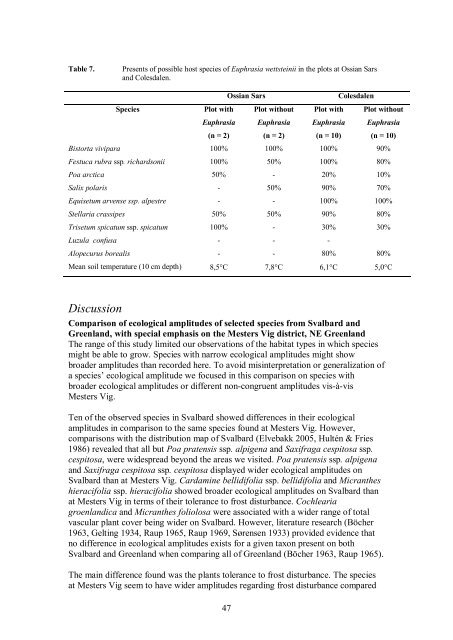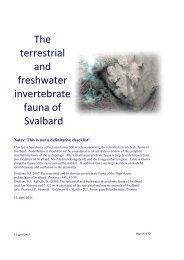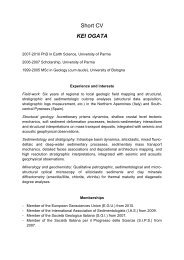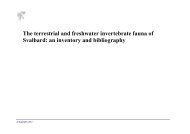Arctic plant ecology: From tundra to polar desert in Svalbard - Unis
Arctic plant ecology: From tundra to polar desert in Svalbard - Unis
Arctic plant ecology: From tundra to polar desert in Svalbard - Unis
You also want an ePaper? Increase the reach of your titles
YUMPU automatically turns print PDFs into web optimized ePapers that Google loves.
Table 7. Presents of possible host species of Euphrasia wettste<strong>in</strong>ii <strong>in</strong> the plots at Ossian Sars<br />
and Colesdalen.<br />
Species Plot with<br />
Euphrasia<br />
(n = 2)<br />
47<br />
Ossian Sars Colesdalen<br />
Plot without<br />
Euphrasia<br />
(n = 2)<br />
Plot with<br />
Euphrasia<br />
(n = 10)<br />
Plot without<br />
Euphrasia<br />
(n = 10)<br />
Bis<strong>to</strong>rta vivipara 100% 100% 100% 90%<br />
Festuca rubra ssp. richardsonii 100% 50% 100% 80%<br />
Poa arctica 50% 20% 10%<br />
Salix <strong>polar</strong>is 50% 90% 70%<br />
Equisetum arvense ssp. alpestre 100% 100%<br />
Stellaria crassipes 50% 50% 90% 80%<br />
Trisetum spicatum ssp. spicatum 100% 30% 30%<br />
Luzula confusa <br />
Alopecurus borealis 80% 80%<br />
Mean soil temperature (10 cm depth) 8,5°C 7,8°C 6,1°C 5,0°C<br />
Discussion<br />
Comparison of ecological amplitudes of selected species from <strong>Svalbard</strong> and<br />
Greenland, with special emphasis on the Mesters Vig district, NE Greenland<br />
The range of this study limited our observations of the habitat types <strong>in</strong> which species<br />
might be able <strong>to</strong> grow. Species with narrow ecological amplitudes might show<br />
broader amplitudes than recorded here. To avoid mis<strong>in</strong>terpretation or generalization of<br />
a species’ ecological amplitude we focused <strong>in</strong> this comparison on species with<br />
broader ecological amplitudes or different noncongruent amplitudes visàvis<br />
Mesters Vig.<br />
Ten of the observed species <strong>in</strong> <strong>Svalbard</strong> showed differences <strong>in</strong> their ecological<br />
amplitudes <strong>in</strong> comparison <strong>to</strong> the same species found at Mesters Vig. However,<br />
comparisons with the distribution map of <strong>Svalbard</strong> (Elvebakk 2005, Hultén & Fries<br />
1986) revealed that all but Poa pratensis ssp. alpigena and Saxifraga cespi<strong>to</strong>sa ssp.<br />
cespi<strong>to</strong>sa, were widespread beyond the areas we visited. Poa pratensis ssp. alpigena<br />
and Saxifraga cespi<strong>to</strong>sa ssp. cespi<strong>to</strong>sa displayed wider ecological amplitudes on<br />
<strong>Svalbard</strong> than at Mesters Vig. Cardam<strong>in</strong>e bellidifolia ssp. bellidifolia and Micranthes<br />
hieracifolia ssp. hieracifolia showed broader ecological amplitudes on <strong>Svalbard</strong> than<br />
at Mesters Vig <strong>in</strong> terms of their <strong>to</strong>lerance <strong>to</strong> frost disturbance. Cochlearia<br />
groenlandica and Micranthes foliolosa were associated with a wider range of <strong>to</strong>tal<br />
vascular <strong>plant</strong> cover be<strong>in</strong>g wider on <strong>Svalbard</strong>. However, literature research (Böcher<br />
1963, Gelt<strong>in</strong>g 1934, Raup 1965, Raup 1969, Sørensen 1933) provided evidence that<br />
no difference <strong>in</strong> ecological amplitudes exists for a given taxon present on both<br />
<strong>Svalbard</strong> and Greenland when compar<strong>in</strong>g all of Greenland (Böcher 1963, Raup 1965).<br />
The ma<strong>in</strong> difference found was the <strong>plant</strong>s <strong>to</strong>lerance <strong>to</strong> frost disturbance. The species<br />
at Mesters Vig seem <strong>to</strong> have wider amplitudes regard<strong>in</strong>g frost disturbance compared








